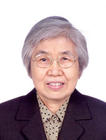

Chen Kunqiu (1936- ) is a native of Shanghai. She graduated from Mathematics and Mechanics Department, Peking University with a major in computational mathematics in 1957. She is chief director of Computer Science and Technology Research Institute, Peking University, who is in charge of software designing. Since 1975, she was responsible for software designing in Huaguang and Founder Electronic Publishing System. She was the developer of China's first practical typesetting software, which was more functional, more flexible and more convenient than the other typesetting software available. She was conferred the title of "March 8 (International Women's Day) Red-Banner Pacesetters" in 1983. In 1987, Huaguang Type III computer-laser typesetting system received State Science and Technology Progress Award, First Class. She was one of the major recipients. Later, she continued to develop Huaguang Type IV computer-laser typesetting software, which won State Significant Technological Equipment Achievement Award, Special Class. Beida Huaguang and Beida Founder have delivered an output value of more than 1 billion yuan in RMB since put into market in October, 1988.
HARDWARE AND SOFTWARE OF THE CHINESE IMAGESETTING SYSTEM
Wang Xuan, Chen Kunqiu and Zheng Min
(Peking University)
Abstract
The traditional hot lead typesetting method used in China has been replaced by the computerized typesetting system now being used by more than 1000newspapers including all the major dailies and 1000obook publishers, printing houses and offices in China. The system has also been exported to Taiwan, Hong Kong, Macao, Singapore, Malaysia, Indonesia and the United States. Prof-Wang Xuan is the chief designer of the system.
The crucial problems in developing an advanced Chinese typesetting system are high resolution Chinese font storage and fast generation. Unlike Latin-based languages, Chinese contains a very large character set, among which 7000 characters are in common use. The diversity of newspaper and periodical layout needs about 40 font styles and 20 type sizes. The output resolution should be high enough, for example 1000 dots per inch, to guarantee graphic art quality. If we put all the digitized Chinese characters of different styles and sizes into computer storage, it would occupy 1010 bytes if data compression technique was not used. A unique method of classifying Chinese character strokes into regular strokes (which are mainly composed of straight segments and starting, ending and turning features) and irregular strokes, and combining stroke feature description by parameters and outline description was invented by Prof. Wang Xuan to precisely describe various strokes of Chinese characters in 1976. The parameter description also specifies width, degree of slants which are the sensitive parts of the regular strokes. These parameters are extremely important in guaranteeing character rendering quality during scaling. The role it plays is quite similar to that of "HINT" which became prevailing in the mid 1980s. The high density and complexity of Chinese character forced Prof. Wang to conceive a new method to control the character rendering quality earlier than the western scientists. The compression ratio is very high and a 60 MB disc is sufficient for the storage of all the Chinese characters used in printing industry. Reproduction of character images from the compressed representation is done by special hardware which performs an elaborate algorithm. The hardware is based on a powerful VLSIASIC specially designed for the purpose. The rasterisation speed is very high.
Prof. Chen Kunqiu and Zheng Min are responsible for the software system. The system supports two different styles of composition software: batch processing mode and interactive mode. The batch processing composition software features simple language, powerful functions, automatic generation of sophiscated formats, comprehensive syntax checking capability and exact proofreading display on screen. It can typeset mathematical formulas, chemical structures and complex tables with ease.
The interactive software WITS (MS Windows-based Integrated Typesetting System) is a highly integrated composition software system which consists of a set of composing tools, including a kernel page makeup software, several special purpose composing tools for mathematical and chemical equations, tables, music scores, chess and bridge manuals etc. and some other supplementary tools ,such as Font Maker. The tools in the integrated system are all established on a multi-window environment with a predefined data exchange protocol and some internal shared data structures. Under such an environment all tools can work together and communicate each other, thus form an integrated software system for electronic publishing. WITS features high integrity and ease of maintenance and expansion, powerful composition functions, friendly user interface, normalized composition layout and wide range of application.